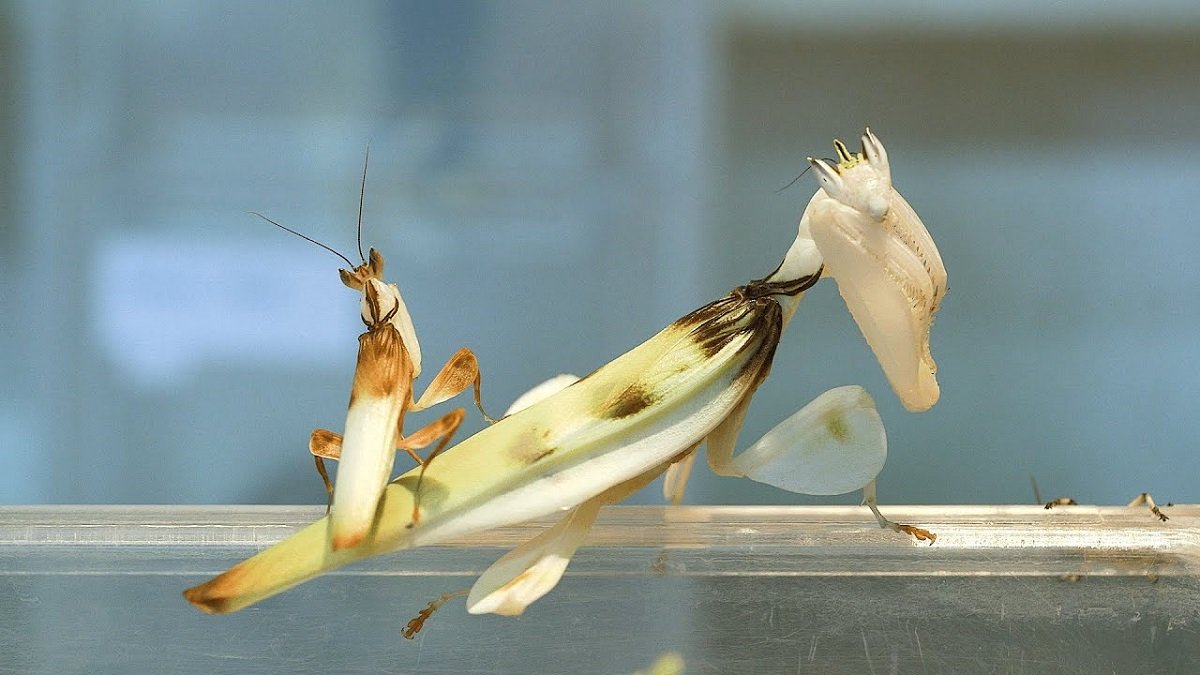The Orchideen Mantis commonly known as the orchid mantis (Hymenopus coronatus) is a creature that captivates nature lovers, biologists, and insect enthusiasts alike with its intricate beauty and mastery of disguise. Native to the rainforests of Southeast Asia, this elusive mantis has evolved to resemble the delicate petals of an orchid flower, blending seamlessly with its environment to both hunt and evade predators. With its remarkable appearance and fascinating behaviors, the orchid mantis stands out as one of nature’s most stunning examples of mimicry.
Physical Characteristics and Appearance
At first glance, the orchideen mantis could easily be mistaken for a delicate pink-and-white blossom. Its body shape and color closely mimic orchid flowers, allowing it to remain hidden in plain sight among tropical foliage. This disguise is not just for show; it serves as a powerful evolutionary advantage. By blending in with flowers, the mantis can attract unsuspecting prey while staying safe from predators.
Female orchid mantises, which are significantly larger than males, can reach up to 7 centimeters in length. Their coloration ranges from pale pinks and whites to bright hues, with petal-like structures on their legs that add to the floral illusion. Males, on the other hand, are smaller and darker in color, which aids them in avoiding detection while they travel in search of mates.
The distinctive coloration of the orchid mantis is adaptive. When positioned against an actual orchid or similarly colored plant, the mantis becomes almost indistinguishable. This ability to blend into the background has a dual function: it allows the mantis to hunt effectively by surprising prey, and it offers protection from potential predators.
The Science Behind the Mimicry
The orchideen mantis is one of the most celebrated examples of aggressive mimicry in the insect world, where an animal imitates something that attracts its prey. In the case of the orchid mantis, it imitates the appearance of a flower to lure pollinating insects such as bees, butterflies, and flies. Unlike other mantises that rely solely on camouflage to blend into the background, the orchid mantis actively entices its prey by posing as a flower.
Research has shown that the orchid mantis is not only capable of mimicking a specific flower but can also adjust its color to match its surroundings, a feature known as cryptic polymorphism. When hunting, the mantis can sit motionless for hours, waiting for an unsuspecting insect to come close enough for it to strike. Once within reach, the mantis uses its powerful forelegs to snatch its prey, capturing it with a lightning-fast reflex that few insects can escape.
In a 2013 study conducted by researchers from Macquarie University in Australia, scientists observed that pollinating insects were more attracted to orchid mantises than to real flowers, suggesting that the mantis may be even more effective at luring prey than the flowers it mimics. This unique ability gives the mantis an edge in capturing prey and underscores its importance in the study of adaptive evolution.
Life Cycle and Behavior
Orchideen mantises have a fascinating life cycle that begins with their emergence from eggs. Once hatched, young mantises are typically red or black in color, helping them blend into their surroundings and avoid predators in their early, vulnerable stages. As they grow, they molt several times, gradually developing the iconic pink-and-white hues that help them blend in with flowers.
The behavior of the orchid mantis also sets it apart. While many mantis species are solitary, females can be more aggressive and territorial, especially during mating season. The male orchid mantis must be cautious when approaching a female to mate, as she may sometimes mistake him for prey. After mating, the female lays her eggs in a foamy sac, called an ootheca, which provides protection and moisture to the developing eggs. The cycle then repeats as new generations emerge.
The Orchid Mantis in Captivity
Due to its stunning appearance and intriguing behaviors, the orchideen mantis has become popular among exotic pet enthusiasts. Keeping an orchid mantis in captivity requires attention to specific environmental conditions. They thrive in warm, humid environments that replicate the tropical habitats of Southeast Asia, and they require ample hiding places and a diet of live insects like fruit flies and crickets.
Caring for an orchid mantis is no small feat. They are sensitive to changes in temperature and humidity, and their diet must be monitored to ensure proper nutrition. Despite these challenges, many hobbyists find it rewarding to observe the mantis’s unique hunting techniques and watch it grow through its various life stages.
Conservation and Ethical Considerations
While orchid mantises are not currently endangered, the destruction of tropical rainforests poses a potential threat to their natural habitats. Habitat loss affects countless species, and the orchid mantis is no exception. The increasing popularity of orchid mantises in the pet trade also raises ethical questions about the impact of removing these creatures from the wild. Conservationists emphasize the importance of sourcing captive-bred mantises to reduce the impact on wild populations.
Fascination with the Orchid Mantis
The allure of the orchid mantis lies in its almost magical ability to transform into what appears to be a delicate blossom. It is a prime example of how nature uses mimicry and adaptation for survival. This mantis demonstrates the delicate balance of ecosystems, where each species plays a specific role and adapts in unique ways to its environment.
For scientists, the orchid mantis offers valuable insights into evolutionary biology and mimicry. For hobbyists and naturalists, it serves as a source of endless fascination and beauty. Whether observed in the wild or admired as a pet, the orchid mantis remains one of the world’s most extraordinary and enigmatic creatures.











